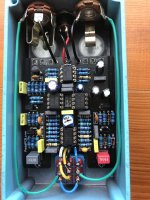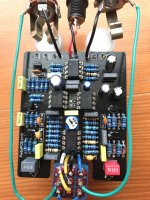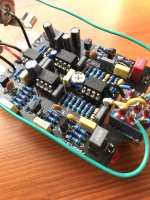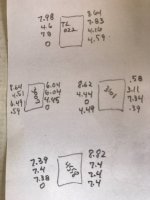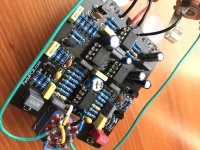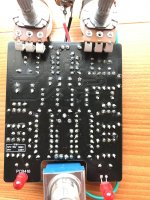Hi everyone,
Just built a Cepheid Chorus.
When I first tested it, I got a whooshing staticky sound. Bypass works. The led light comes on. The LFO light remains on, doesn't flash. I used a probe and got clean sound up to R24, right before the signal goes into the 3007. After the 3007 it was static.
The next morning, magically, the whooshing static was gone, but there was no chorus effect. I could hear it trying but really nuttin'. The LFO remains steady on.
The non-chorus sound happens boxed or un-boxed. So I don't think it's a something's touching the inside of the box and grounding something out situation.
I adjusted the trimmer pot and still nuttin'.
For voltage measurements see pic. I don't know if these are correct or not but power is getting through.
Please take a look and let me know what you think.
Thanks!
Dave
***********************************
Days later...
The "Fix". For those keeping score at home, the chorus now works but I didn't actually fix it. It sort of fixed itself... very unsatisfying. Maybe an IC was loose and as I was going through checking everything I accidentally fixed it. in the future I may reflow some suspect solder joints. but am going to box this dog up for now and use it. thanks for everyone's excellent comments and help.
Just built a Cepheid Chorus.
When I first tested it, I got a whooshing staticky sound. Bypass works. The led light comes on. The LFO light remains on, doesn't flash. I used a probe and got clean sound up to R24, right before the signal goes into the 3007. After the 3007 it was static.
The next morning, magically, the whooshing static was gone, but there was no chorus effect. I could hear it trying but really nuttin'. The LFO remains steady on.
The non-chorus sound happens boxed or un-boxed. So I don't think it's a something's touching the inside of the box and grounding something out situation.
I adjusted the trimmer pot and still nuttin'.
For voltage measurements see pic. I don't know if these are correct or not but power is getting through.
Please take a look and let me know what you think.
Thanks!
Dave
***********************************
Days later...
The "Fix". For those keeping score at home, the chorus now works but I didn't actually fix it. It sort of fixed itself... very unsatisfying. Maybe an IC was loose and as I was going through checking everything I accidentally fixed it. in the future I may reflow some suspect solder joints. but am going to box this dog up for now and use it. thanks for everyone's excellent comments and help.
Attachments
Last edited:


